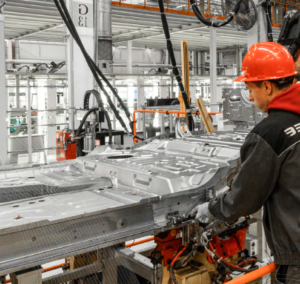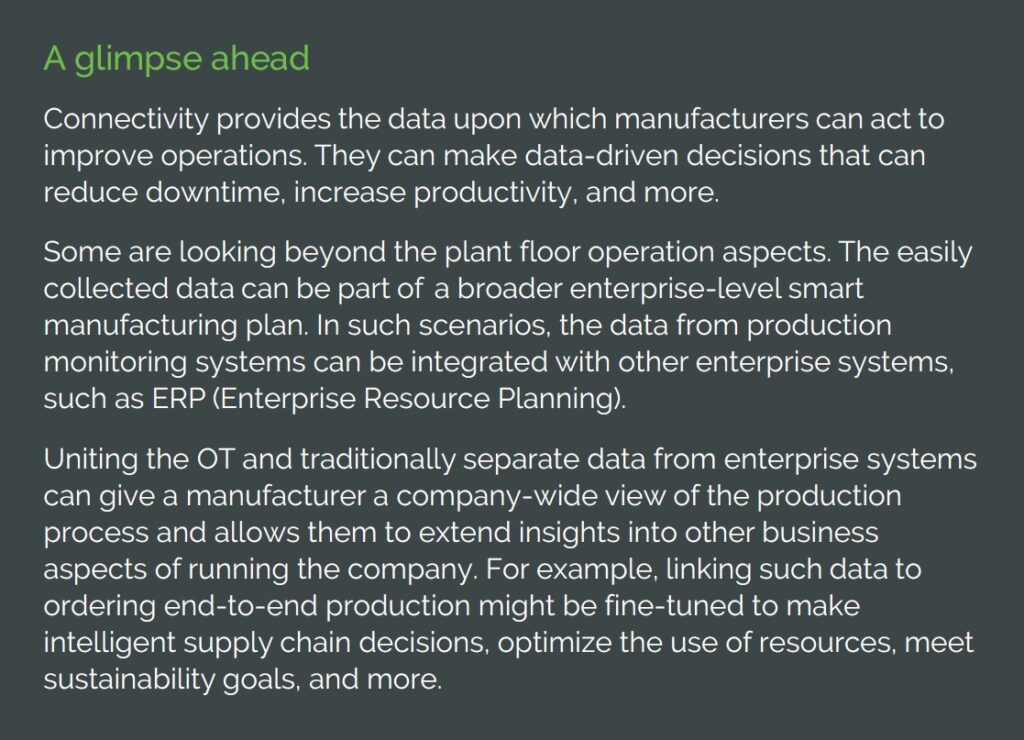Enabling Intelligent Manufacturing With Standardized Connectivity

Chapter 1: Introduction
Manufacturing is facing a number of challenges that have little in common, yet potentially all can be addressed by making use of technological advances.
Some of the issues impacting the industry are long-term problems that continue to impact operations. Manufacturing, like many other industries, is still struggling with supply chain and logistics problems that started during the pandemic and have not yet been fully resolved.
Global competition is as fierce as it ever was. As a result, manufacturers must cut costs, innovate more rapidly, and offer their customers more choices and support.
Additionally, all types of manufacturers face new issues. There are growing environmental pressures from governments, boards of directors, shareholders, and customers alike. That is driving the need for manufacturers to optimize resources, minimize waste, reduce energy consumption, and more.
Also new is that customers today are much more demanding. They expect highly customized offerings and high-quality products, all delivered faster than ever before.
Intertwined with these issues is the general need to be more operationally efficient. Some efforts focus on using more automation. Others find manufacturers trying to be more proactive to reduce downtime and improve maintenance efficiency. In all cases, the goal is to get the most output from production lines while keeping an eye on costs.
Technology as the Conduit to Intelligent Manufacturing
For years, manufacturing has focused on the potential benefits of technologies, embracing new ones as they emerge. Automation and robotics are mainstays in most production lines and manufacturing plants.
Now, the attention is on digital technologies. The Internet of Things (IoT) and other smart sensors provide a wealth of data about the operating state of equipment. That data, if collected and analyzed, can provide insights to spot problems before they occur, keep production lines running, optimize operations, and more.

That is the foundation of what many call intelligent manufacturing. Such efforts are the domain of the operations side of the house. The data and analytics might eventually become part of a higher-level strategy, but for many manufacturers, the availability of such data is a critical step to making smarter operational decisions.
In such context, intelligent manufacturing, which is often associated with the term Industry 4.0, refers to the integration of advanced technologies and practices into the production process with the goal of increasing efficiency, productivity, and customization. There is great interest in embracing intelligent manufacturing for those reasons and more.
But governments are also getting into the picture. Some see intelligent manufacturing as a way to boost the economy and gain a competitive edge globally. Some are providing incentives, have regulations in place, or are articulating strategies to promote intelligent manufacturing. For example, in 2022, the U.S. Department of Energy issued a National Smart Manufacturing Strategic Plan.
The plan touched on many of the issues highlighted above. It noted that many manufacturers, particularly those that currently have energy-intensive operations, can benefit from intelligent manufacturing technologies. However, it noted what is needed is the right technical improvements to realize any benefits. Specifically, it noted that manufacturers must overcome the technical barriers to deploying advanced sensors and communication technologies for existing manufacturing assets.
Unfortunately, while the modern factory floor and production lines are strewn with devices that produce data, traditional OT SCADA systems, which are used to manage manufacturing facilities and shop floors, have limited connectivity options. They were not designed for IoT scalability, resulting in siloed data from complex and mixed solutions on their factory floors.
The starting point in any transition to intelligent manufacturing is to develop a connectivity and data strategy. That would require a connectivity solution that can bring disparate data together. Additionally, a solution must support a high volume of devices and a wide variety of protocols since many different ones are in use on the factory floor.
Once the connectivity is in place, that then provides manufacturers with access to data to better manage operations, spot problems in the making, resolve issues faster, and plan changes.
Chapter 2
How to Proceed: The Path to Intelligent Manufacturing
Undertaking a move to intelligent manufacturing requires a roadmap where the steps include process planning, process validation, production planning, and production execution. Let’s dig a bit deeper.
Any plan must first start with a clear vision of what needs to be accomplished. In this case, the goal is to connect the IoT and smart sensors on siloed devices scattered throughout a production line or entire plant.
A Need for Standardized Communications
Many of the elements generating data are likely to use different communications protocols. And some of these will be proprietary to that specific manufacturer. So, a needed step is to do a gap analysis where all devices are surveyed, and the communications protocols they use are identified.

Having this information, a manufacturer can then look for a solution that provides secure, standardized, and seamless connectivity between the industrial devices and software platforms used by the facility.
Having a solution that includes a portfolio of industrial connectivity solutions will let the manufacturer connect diverse devices. It should work with newer devices that use modern and standard communications protocols, as well as with existing older equipment that might use proprietary protocols. That simplifies the process of collecting, monitoring, and controlling data from multiple sources. And that, in turn, lets a manufacturer make use of the data to optimize their operations, improve efficiency, and make data-driven decisions.
Data Management and Quality Issue Considerations
Once standardized connectivity is in place, manufacturers will find any platform or solution they use to collect and use that data must take data management and data quality issues into account.
The number one issue will be the volume of data. The data volume of IoT-connected devices is predicted to grow to 79.4 zettabytes through the year 2025 at a compound annual growth rate (CAGR) of more than 34%, according to market research and analyst firm Statista.
So, any manufacturer that connects all equipment and devices via a standardized communications solution will be collecting large volumes of data. It is not just a matter of how many pieces of equipment or sensors are deployed; modern IoT devices often take multiple measurements, and many make those measurements in sub-second intervals. Needless to say, data volumes can quickly add up. If too much data is produced, that may result in storage issues and can make it challenging to identify and extract meaningful insights from the data.
Next, there is the issue of data quality. Some of the most important issues include:

- Missing or inconsistent data: An IoT device might occasionally fail or perform poorly. For instance, there might be calibration errors, physical damage, or environmental factors that interfere with data generation. Or intermittent connectivity issues can result in some data lost or not transmitted in real time.
- Data granularity issues: Some IoT devices might record data too frequently, leading to an overwhelming amount of data that is not useful; others may not record data frequently enough, missing important events. And different devices might generate data at different intervals.
- Different formats and protocols: Another challenge is getting all the data into a useful format. Different IoT devices may have different data formats or use different communication protocols. This can create integration challenges and make it difficult to consolidate data from various sources.
- Lack of context: IoT devices capture specific data points but without contextual information. Without contextual details, it might be challenging to interpret the data’s significance.
- Misaligned or tardy data: When integrating data from multiple devices, there might be discrepancies in timestamps. This can affect the ability to conduct accurate real-time analysis or event correlation.
What’s needed is a data solution that will let a manufacturer work with the large amounts of data that can be generated by today’s sensors and IoT devices. The solution should be able to take advantage of modern databases and data lakes for data storage and analysis.
Manufacturers with such connectivity and data solutions in place can then start down the path of intelligent manufacturing.
Chapter 3
Benefits of Intelligent Manufacturing Operations
Many manufacturers have been managing equipment on a one-off basis (using vendor A’s management tools for its equipment and B’s with its tools). Intelligent manufacturing seeks to use data from all devices at once to gain insights into how things work together, complement one another, and can be tuned to optimize overall operations.
The beauty is that once standardized connectivity is in place and there is a suitable way to collect data from all systems, a manufacturer can proceed at its own pace into the realm of intelligent operations. A particularly important point to keep in mind is that there are many areas where the use of the data can be applied. Some of the main areas where manufacturers realize intelligent manufacturing benefits include:

Production Monitoring: Once connectivity is in place, manufacturers can continuously collect data from sensors and IoT devices in real time. That could include data on machine operations, temperatures, pressures, product quality, and many other parameters. The collected data can also be processed and analyzed to provide valuable insights. For example, advanced analytics can help identify bottlenecks, inefficiencies, or deviations from normal operating conditions. And more advanced use of the capabilities might include automated feedback loops where if an anomaly is detected, smart systems could automatically adjust parameters to correct deviations. For example, if a machine is running hot or operating at a higher-than-normal pressure, a smart system might use that information to throttle that piece of equipment back and keep it within normal operating range until someone has a chance to go to the shop floor and inspect it.
Downtime Reduction: The normal process to keep equipment and production lines running is to inspect all elements based on the OEM’s maintenance schedule and replace parts based on the same company’s life expectancy for parts within a piece of equipment. Unfortunately, surprises frequently occur when there is no ability to collect data from the equipment on the plant floor. Equipment fails, and that shuts down production.
Collected data from continuous monitoring can be used to look for any deviations that could be tell-tale signs of a performance drop, an issue that impacts production quality, or a precursor to equipment failure. With that information in hand, a manufacturer can dispatch someone to inspect the equipment and thus prevent a failure that could impact production.
Predictive Maintenance: Reacting in real time as an anomaly is detected is fine. Spotting a problem in the making is better than having equipment unexpectedly fail. But the knowledge that something is amiss does not help if a critical part is not in stock or the equipment is in a location that takes time to reach or is inaccessible. More is possible. That same data examination process for reducing downtime can be taken to a higher level with the use of predictive analytics. In particular, it can foresee potential problems or downtimes, allowing for proactive measures. As such, predictive analytics can help a maintenance staff better plan its work, ensuring the right part is in stock and helping schedule workers to visit the machine before it fails. That helps increase equipment uptime and availability.

Optimized Operations: Perhaps the most important aspect of having a means to collect data from all equipment is that it gives manufacturers the big picture of what is going on in work cells, production lines, and an entire plant. Rather than managing each piece of production equipment individually, aggregated data can be assimilated to provide real-time visibility into the dynamics, interplay, and dependencies of various equipment on operations. With such data, a manufacturer might be able to correlate the high occurrence of a production defect with a piece of equipment that is operating out of range. Some are looking beyond the plant floor operation aspects. The easily collected data can be part of a broader enterprise-level smart manufacturing plan. In such scenarios, the data from production monitoring systems can be integrated with other enterprise systems, such as ERP (Enterprise Resource Planning). Uniting the OT and traditionally separate data from enterprise systems can give a manufacturer a company-wide view of the production process and allows them to extend insights into other business aspects of running the company. For example, linking such data to ordering end-to-end production might be fine-tuned to make intelligent supply chain decisions, optimize the use of resources, meet sustainability goals, and more.
Chapter 4
Bringing it All Together: The Hidden Benefits of the Connected Manufacturing Floor
Traditionally, OT systems like MES, SCADA, PLCs, and CNCs, while containing vast amounts of data, were rarely networked. Many of these systems use proprietary communications protocols. That creates silos of hard-to-reach data. These barriers must be broken down to get value from the wealth of data and embrace intelligent manufacturing.
Once manufacturers become accustomed to having data so easily available, many expand the use of that data beyond standard operational use cases.
Some are using the data to be more flexible. Many applications focus on the data collection and analysis part. Another use is to leverage the connectivity to send data back to the production lines. That is what Teel Plastics is doing. Specifically, the manufacturer can send pre-saved recipes for their different products and formulations to the machines on its production lines. This is a much more efficient and effective method than the previous manual process. It reduced the risk of human error and helped Teel reduce its set-up times by 30 percent.

Another application is spare parts inventory optimization. For years, manufacturers used calendar-based maintenance that relied on vendor-supplied information about a part or piece of equipment’s lifetime and repair history. Maintenance groups would plan inspections, service, and parts replacement based on mean time to failure (MTTF) and end-of-life data. Spare parts were ordered based on the device vendor’s replacement schedule.
As noted above, some manufacturers are using the data collected across the shop floor and plant to implement predictive maintenance. That work can be expanded when the OT data used in these calculations is shared with IT systems, such as ERP systems used to order spare parts. Such a system would make certain required spare parts are in-stock when needed, thus avoiding unnecessary downtime waiting for a critical part to ship. It also guarantees parts are not overstocked spare parts, thus reducing the need for excess storage capacity to house the parts. This also reduces the chance of having outdated parts.
Yet, another way to make use of the data outside of operations is to improve product quality by looping intelligent manufacturing plant data back to engineering and product design. Analyzing data from production systems can provide insights and correlations between the state of the equipment used to produce an item and output quality. Having this information, product designers might tweak product elements or the production process to ensure a high-quality finished product.
Obviously, having connectivity in place for operational issues gives manufacturers the ability to use the data in many ways. These examples are the tip of the iceberg. Many benefits and synergies can be realized by connecting IT and OT systems. But it all goes back to connectivity.
That is where PTC Kepware comes in. Kepware is a software solution developed by PTC that is designed to provide connectivity between various devices and applications. It acts as a reliable communication platform, enabling seamless data exchange and integration. It accomplishes this by supporting numerous protocols and interfaces. Bottom line: Kepware simplifies the process of collecting, monitoring, and controlling data from multiple sources. That allows manufacturers to optimize their operations, improve efficiency, and make data-driven decisions.






















